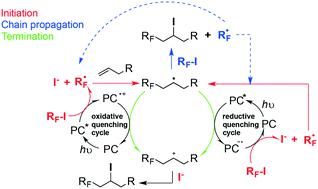当前位置:
X-MOL 学术
›
Catal. Sci. Technol.
›
论文详情
Our official English website, www.x-mol.net, welcomes your feedback! (Note: you will need to create a separate account there.)
The role of photocatalysts in radical chains in homolytic aromatic substitution, radical addition to olefins, and nucleophilic radical substitution mechanisms
Catalysis Science & Technology ( IF 5 ) Pub Date : 2020-06-24 , DOI: 10.1039/d0cy00921k Damian E. Yerien 1, 2, 3, 4 , Sebastián Barata-Vallejo 1, 2, 3, 4, 5 , Erwin W. Mora Flores 1, 2, 3, 4 , Al Postigo 1, 2, 3, 4
Catalysis Science & Technology ( IF 5 ) Pub Date : 2020-06-24 , DOI: 10.1039/d0cy00921k Damian E. Yerien 1, 2, 3, 4 , Sebastián Barata-Vallejo 1, 2, 3, 4, 5 , Erwin W. Mora Flores 1, 2, 3, 4 , Al Postigo 1, 2, 3, 4
Affiliation

|
Photoinitiated perfluorobutylation reactions of 2-anisidine 1, propenyloxybenzene 2, and 2-mercaptoethanol 3 have been carried out employing commercially available n-C4F9I as the source of ˙C4F9 radicals under three different photocatalysts (PCs) absorbing in the violet (Ir[dF(CF3)ppy]2(dtbbpy)+ (PC-1)), green (Rose Bengal (PC-2)) and red (zinc phthalocyanine PhZn (PC-3)) regions of the electromagnetic spectrum, in order to explore the quantum yields and radical chain lengths for each type of transformation and photoinitiated system. For substrates 1–3 and their different types of reactions, the comparative study between PCs seeks to establish the extent to which regioproducts, yields, and mechanistic proposals are influenced by the intervention of each PC. The different overall quantum yields and chain lengths obtained for each type of reaction under each PC are a direct consequence of the efficiency of the photoinitiation events, i.e., primary radical production, propagation and termination steps. This will have important implications in the understanding and representations of the mechanisms postulated, in terms of closed and open catalytic cycles. One strategy we apply to uncover radical propagating chains in our mechanisms is to explore photocatalysts that operate in oxidative and reductive quenching manners for each type of transformation.
中文翻译:

自由基链中光催化剂在均相芳族取代,烯烃中自由基加成和亲核自由基取代机理中的作用
2-甲氧基苯胺的光引发perfluorobutylation反应1,propenyloxybenzene 2,和2-巯基乙醇3已经进行了使用可商购的Ñ -C 4 ˚F 9我为C的源4 ˚F 9组吸收在三个不同的光催化剂的基团(PC)的电磁区域的紫色(Ir [dF(CF 3)ppy] 2(dtbbpy)+(PC-1)),绿色(Rose Bengal(PC-2))和红色(锌酞菁PhZn(PC-3))区域光谱,以探索每种类型的转化和光引发体系的量子产率和自由基链长。对于基材在1-3和它们不同的反应类型之间,PC之间的比较研究试图确定每台PC的干预对区域产物,产量和机械提议的影响程度。在每种PC下,每种类型的反应获得的不同的总量子产率和链长是光引发事件效率的直接结果,即,主要自由基的产生,繁殖和终止步骤。对于封闭的和开放的催化循环,这将对理解和表示假定的机理具有重要的意义。我们用来揭示自由基传播链的一种策略是探索针对每种类型的转化以氧化和还原猝灭方式运行的光催化剂。
更新日期:2020-08-05
中文翻译:

自由基链中光催化剂在均相芳族取代,烯烃中自由基加成和亲核自由基取代机理中的作用
2-甲氧基苯胺的光引发perfluorobutylation反应1,propenyloxybenzene 2,和2-巯基乙醇3已经进行了使用可商购的Ñ -C 4 ˚F 9我为C的源4 ˚F 9组吸收在三个不同的光催化剂的基团(PC)的电磁区域的紫色(Ir [dF(CF 3)ppy] 2(dtbbpy)+(PC-1)),绿色(Rose Bengal(PC-2))和红色(锌酞菁PhZn(PC-3))区域光谱,以探索每种类型的转化和光引发体系的量子产率和自由基链长。对于基材在1-3和它们不同的反应类型之间,PC之间的比较研究试图确定每台PC的干预对区域产物,产量和机械提议的影响程度。在每种PC下,每种类型的反应获得的不同的总量子产率和链长是光引发事件效率的直接结果,即,主要自由基的产生,繁殖和终止步骤。对于封闭的和开放的催化循环,这将对理解和表示假定的机理具有重要的意义。我们用来揭示自由基传播链的一种策略是探索针对每种类型的转化以氧化和还原猝灭方式运行的光催化剂。



























 京公网安备 11010802027423号
京公网安备 11010802027423号